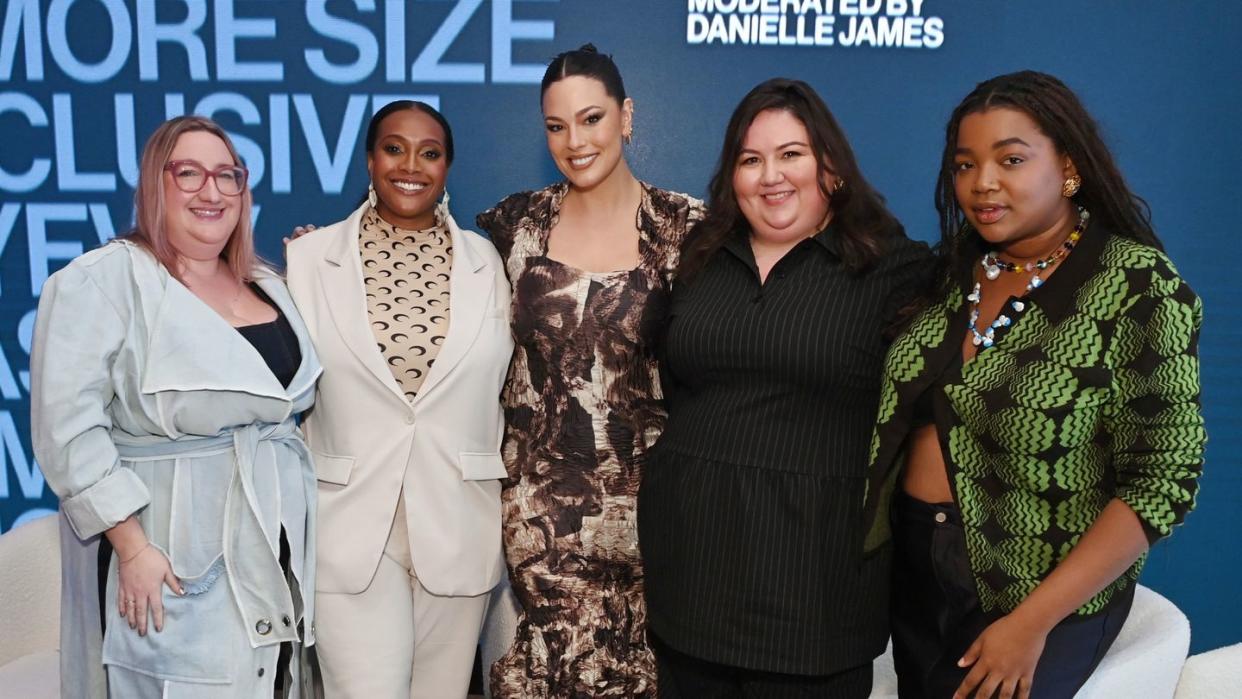How Can We Improve Plus-Size Representation at NYFW?

During New York Fashion Week in September, ELLE.com published a story co-written by digital beauty director Danielle James and plus-size fashion expert and influencer Sarah Chiwaya titled “Where Have All the Plus-Size Bodies Gone?” The piece detailed the history of size inclusion at NYFW, and 10 industry veterans weighed in on their disappointment in the lack of progress over the past decade. As James and Chiwaya pointed out, even though over 67 percent of women in the U.S. are a size 14 or above, only 5 percent of models cast for NYFW in 2022 were plus-size. While some CFDA designers like Christian Siriano and Prabal Gurung consistently include plus-size pieces in their collections—with more than 90 shows on the official NYFW calendar and over 300 shows that happen each season, representation is non-existent.
At IMG’s official NYFW kick-off event, James moderated “Fashioning a More Size Inclusive NYFW, a NYFW Backstage panel hosted by ELLE.com and IMG models, that celebrated a decade of plus-size representation at NYFW and discussed ways in which the industry can improve. The speakers included Chiwaya, model Ashley Graham, fashion stylist and editor Gabriella Karefa-Johnson, and IMG Models director Mina White. Here are five main takeaways from the conversation:
Without major action, inclusivity will ultimately be a fad.
While a handful of plus-size models have reached supermodel status, including Graham, Paloma Elsesser, and Precious Lee, White pointed out that the industry seems to be dragging its feet when it comes to discovering new plus-size talent. “The problem is that they’re tokenizing big names who bring buzz, who bring headlines, but they’re not thinking about the next generation. And so if we don’t have the next generation of curve girls, or we can’t break new stars, at some point, this is gonna end, and it will be a fad,” she explained. White’s proposed solution? Power players in the industry mandating size diversity in every show, which can be as simple as having more models on the runway representing sizes beyond zero.
We need to actively listen to plus-size women.
Karefa-Johnson emphasized that brands should hire more women of different sizes that reflect plus-size consumers. “I don’t think that these brands are thinking about that when it comes to size inclusivity. Are you bringing in larger bodies to say, ‘This is what this woman wants to wear’?” Meanwhile, Chiwaya, who has consulted for various brands considering expanding their size ranges, has discovered that the same people who hire her for advice are often unwilling to listen. “I’ll be the only plus size person in the room while they’re talking about plus size fashion. And an older man will contradict me, saying, ‘Oh, that’s not what women want.’ And I have a really deep knowledge of this community and what sells. I see the numbers, and people will contradict that because they have this idea of what plus-size women want,” she said. “So I think getting people in the room is really important, but I also think [we need to make] sure they are actually empowered,” she added.
Improved grading is a major way designers can be more inclusive.
In fashion, grading is the process through which designers turn a sample size (usually ranging from a size zero to two) into smaller and larger sizes. Often, grading doesn’t change the shape of the piece; it only alters the size. The problem with that is that what looks good on a size two isn’t necessarily going to work for a size 20. “A lot of sample sizes are made in a zero or two. To grade that up all the way up to a size 16 is nearly impossible. You need to have different sample size models in between [zero and 16] and then up even more because nobody's body is built the same way as the next person.” Graham said. Improved grading enhances the quality of fit for all sizes.
Fast fashion is leading the way—it’s high time for high fashion to follow.
While fast fashion has countless pitfalls, including the promotion of overconsumption—one thing it has gotten right is catering to plus-size consumers with trendy ensembles. Karefa-Johnson explained, “The way that they treated their plus consumer is astute and apt because instead of serving minimization culture, like, this is about looking skinnier, they actually are subscribing to trend, which is the way that straight-size shoppers have shopped for their whole life. But for some reason, fat women are not supposed to be interested in fashion; they’re just supposed to be interested in making themselves look smaller. Fast fashion threw away that pretense.”
We’ve made progress, but not enough.
For the past decade, Graham has been the face of plus-size fashion, which has come with its challenges—it’s impossible, after all, for one woman, with one body, to represent an entire community. “I’ve never sought after that. I was just here to work as a team to change an industry, not even knowing that the industry was going to change,” she said. Graham hopes that in the coming years, the conversation will shift from the body under the fabric to how the fabric was transformed into clothing, the true beauty of fashion. And she’s not just hopeful—she’s excited. “There’s so many things that we have seen that have changed to the core of what you would think of as ‘plus-size fashion.’ Yet it sucks when you feel the tokenism, when you feel that the designers are pushing us out. But I always remind myself because I’m a very ‘the-glass-is-half-full’ kind of girl, that there is so much that has already changed, and we really need to focus on that. And then what are we doing as a collective to keep pushing forward for the next 10 years?”
You Might Also Like


